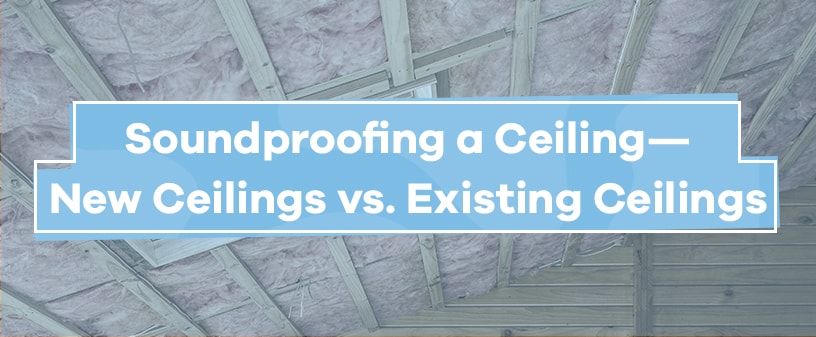
Table of Contents:
Types of Ceiling Noise
Types of Materials for Soundproofing Projects
How to Soundproof a Ceiling
Soundproof Existing Ceiling
Your soundproofing isn’t complete until you’ve soundproofed your ceiling. If there’s anything on the floor above you, sound can easily travel down into your apartment, condominium or home without adequate soundproofing. But how do you soundproof a ceiling? Your approach will vary depending upon whether you’re putting in a new ceiling or you have an existing ceiling. If it’s the latter, you’re probably interested in soundproofing a ceiling without removing drywall or ripping up your existing ceiling.
If you’re building a new ceiling, this is the perfect time to add soundproofing. Whether you’re building a hotel, apartment or multi-story home, guests and residents will appreciate not having to deal with excessive noise from above.
If you have an existing ceiling, you may not want to go through the expense of tearing it out and starting over just to add soundproofing.
Fortunately, you don’t have to. In fact, keeping the existing ceiling and adding more soundproofing may provide even better soundproofing than ripping out the drywall and starting over. Here’s what you need to know to carry out either procedure.
Types of Ceiling Noise to Eliminate With Soundproofing
Before you soundproof your new or existing ceiling, you’ll want to consider the type of noise you’re seeking to eliminate. There are two primary varieties of noise in buildings:
- Airborne noise: As the name would suggest, airborne sound moves through the air. Sources of noise produce soundwaves that flow through the air until they meet a solid object, such as your wall or ceiling. But hard surfaces can’t totally absorb noise — that’s why sound travels through walls and into other rooms.
- Structural noise: Traveling through your floorboards, ceilings and walls, structural noise occurs when an object makes a direct impact on a structure. This collision sends soundwaves through the impacted surface, which is why you’ll hear the impact from footsteps or a dropped object upstairs.
Shop Ceiling Soundproofing Materials
Types of Materials for Soundproofing Projects
There are four common ways to address the airborne and structural noise that affect your ceiling — decoupling, absorption, adding mass and sound dampening. Here are the materials that will help you implement each technique.
Materials for Decoupling
To decouple your ceiling, separate the drywall from the joists by installing a hat channel. The isoTRAX™ Soundproofing System is a bar that attaches to the studs and runs along the width of your ceiling.
The system features rubber pads that cushion the places where the channel and studs connect. Rather than screwing the drywall into the studs, you screw it into the isoTRAX hat channel. The rubber pads will absorb vibrations on either side of the ceiling.
Materials for Absorption
There are materials that absorb sound before it hits the ceiling and after it passes through the first layer.
To address noise before it hits your ceiling’s reflective surface, install materials like acoustic baffles or acoustic panels. An acoustic baffle suspends from your ceiling, leaving a few inches between. Baffles have two soft, porous sides that absorb noise upon impact. Separating the baffle from the ceiling allows it to address noise before and after it hits the ceiling. An acoustic panel installs directly onto the ceiling to absorb noise.
You can absorb noise that breaches your wall’s first layer by installing acoustic insulation. Slip batts of acoustic insulation into your ceiling as you install a new one. Either install the insulation as you add drywall or install wooden studs to keep the insulation in place and support the ceiling’s structure.
Materials for Adding Mass
A heavier, more dense ceiling is better at preventing noise from transferring to and from the room above.
The best material you can use to increase your ceiling’s mass is mass loaded vinyl (MLV). A MLV barrier is a heavy vinyl sheet that blocks noise. A layer of nonporous foam on either side of the barrier reflects noise to further limit the amount that reaches the other side.
You can install MLV into your ceiling by fastening it to the inside of your new drywall. You could also install the MLV barrier to the outside of the drywall and cover it with tiles.
Materials for Sound Dampening
Sound dampening is the process of reducing structural vibrations. Hat channels like the isoTRAX™ Soundproofing System offer sound-dampening properties through the rubber padding that separates the channel from the joist. Acoustic insulation can also weigh down the ceiling to absorb vibrations.
Here are some other ways to dampen vibrations that come through your ceiling:
- Apply Silent Running SR-500 coating before painting the ceiling.
- Stick a Vibra Block® sheet onto the ceiling’s interior surface.
- Place rubber isolators over the joists.
How to Soundproof a Ceiling
So how do you soundproof a brand-new ceiling? You’ll need to use drywall, hat channels — which provide the frame you attach the drywall to — and soundproofing material, like Quiet Batt™ soundproofing insulation. You may also need new joists. With these materials in hand, follow these steps to soundproof your new ceiling:
- Attach the hat channels across the joists about 16 inches apart.
- With the hat channels attached, slip in your soundproofing material above the joists. Soundproofing material will add weight, so you may wish to add additional joists for support.
- Once the soundproofing material is in, add two layers of drywall.
If you’re soundproofing a new ceiling, you can find everything you need for the process by ordering Soundproof Cow New Ceiling Soundproofing Assemblies online.
How Do You Soundproof an Existing Ceiling Without Removing Drywall?
If you’re willing to tear up your existing ceiling, you can follow the same procedure as for a new ceiling soundproofing installation. If you already have a ceiling you don’t want to remove, you’ll have to get creative — and maybe build a second ceiling. Here are a few ways you can soundproof an existing ceiling without tearing up drywall.
1. Install a Drop Ceiling
The surest way to soundproof a ceiling without tearing it apart is to add a second ceiling below the first. This way, you’ll be able to incorporate soundproofing insulation as if you were installing a brand new ceiling. Dropping your ceiling is a manageable project — attach the hat channels to the existing ceiling, then proceed with the procedure as outlined above. The effect will be the same, but you’ll have a slightly lower ceiling.
You can find all the materials you need to soundproof an existing ceiling by ordering Soundproof Cow Existing Ceiling Soundproofing Assemblies. Just keep in mind that your ceiling should be at least 7.5 feet tall after the drop.
2. Hang Curtains From the Ceiling
To complement your drop ceiling or to make do with your room’s current ceiling, hang some curtains from above. The thicker, the better. Try thick blankets, carpets or even old mattress pads if you’re not too worried about the look. Ceilings are generally hard and flat, so anything you can do to produce a soft, irregular surface will prevent noise from escaping.
3. Add Some Decorations
Carpets, quilts, curtains and other soft decorations are a quick, cost-effective way to soundproof your room with the current infrastructure intact. These additions you already have lying around the house provide a greater amount of absorptive surface area that will trap sound. Even paintings will mitigate airborne noise more effectively than bare walls.
4. Use Furnishing to Your Advantage
If you want to keep sound in, fill your room with fluffy, comfy furniture. The more irregular and soft surfaces for sound to bump into, the better. Incorporating dressers, drawers, plants and other furnishings that complete your room aesthetically will provide sonic benefits, too. The more surfaces you have in your room, the fewer pathways airborne sound will have to escape.
5. Implement Soundproofing Materials
From acoustic foam to soundproofing barriers and hanging baffles, intentionally crafted soundproofing materials will seal your room and look professional. Soundproof Cow carries all the materials you need to limit the amount of noise that enters or exits your room.
6. Soundproof the Floor Above
If possible, consider installing soundproofing material into the floor above your room. Products like Impact Barrier QT Flooring Underlayment will prevent airborne noise from leaking into the room upstairs while limiting the effects of impact noise on your space.
Soundproof New and Existing Ceilings With Soundproof Cow
Soundproof Cow has all the materials you need, whether you’re soundproofing a new ceiling or trying to soundproof an existing ceiling without removing drywall. For more information and to order the products you need, including full ceiling soundproofing assemblies, visit Soundproof Cow.







